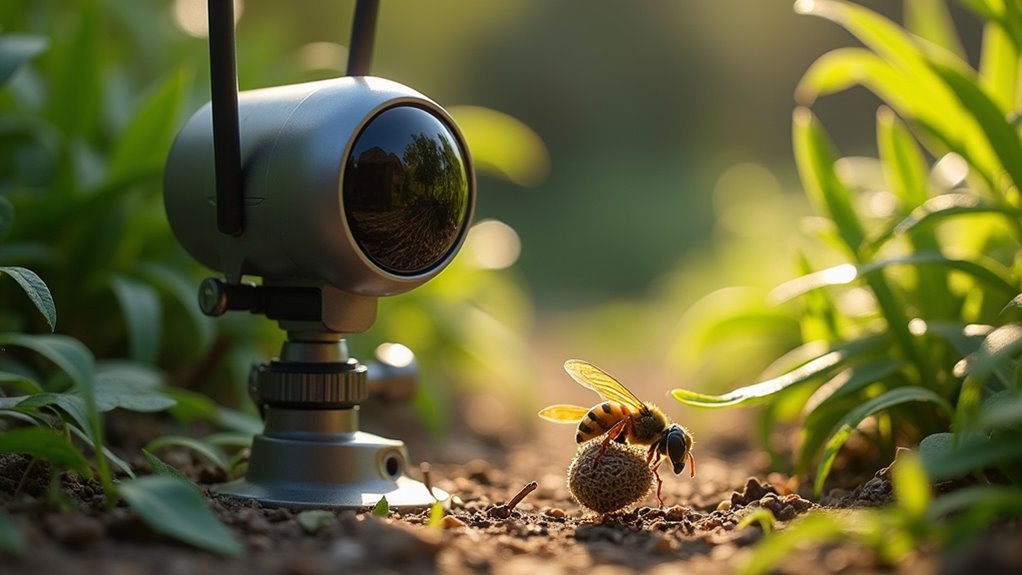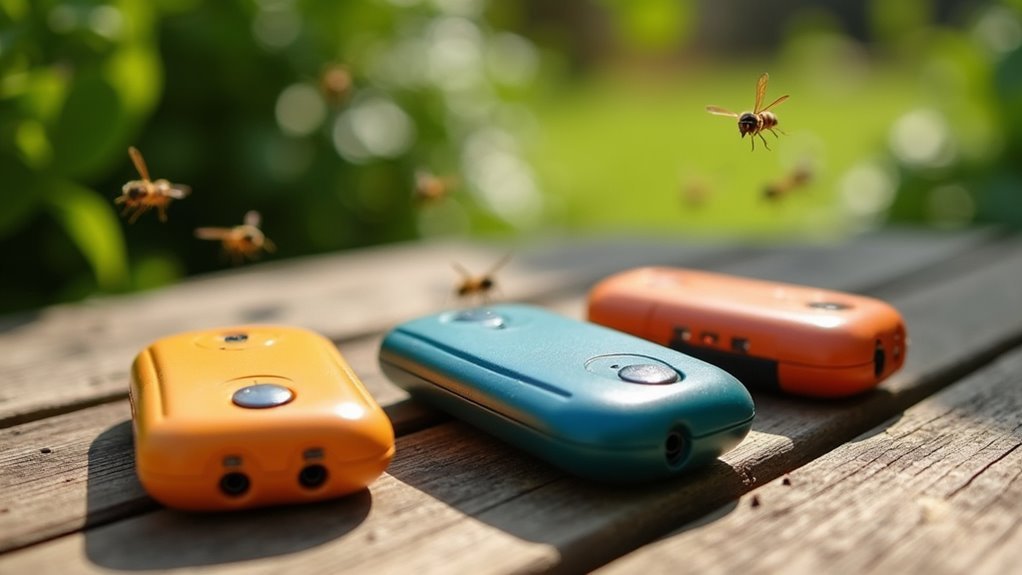You’ll find that motion-activated cameras with smartphone alerts work exceptionally well for under $50, providing real-time wasp detection and species identification. Sticky traps cost under $20 and offer immediate visual feedback when placed near food sources, while DIY sugar water stations using equal parts water and sugar create irresistible bait that traps wasps effectively. Ultrasonic monitors cover 1,000-3,000 square feet, and smartphone apps with GPS mapping help track local nest locations. These proven methods will give you thorough insights into wasp activity patterns around your property.
Motion-Activated Cameras for Wasp Surveillance

While traditional wasp monitoring methods often fall short, motion-activated cameras offer you a sophisticated yet affordable solution for tracking wasp activity around your property.
These cameras capture real-time footage, helping you identify nesting behaviors and peak activity times essential for effective control measures.
You’ll benefit from infrared night vision capabilities that detect nocturnal wasp movement, plus smartphone alerts that notify you immediately when wasps are spotted.
The high-definition video quality lets you clearly identify specific wasp species, enabling you to choose appropriate deterrent strategies.
Advanced models include two-way audio and cloud storage for remote monitoring.
This thorough surveillance approach makes timing your nest removal efforts considerably more effective and safer.
Sticky Trap Monitoring Systems Under $20
You’ll find sticky traps offer an excellent budget-friendly alternative to high-tech surveillance equipment for monitoring wasp activity around your property.
These simple yet effective devices typically cost under $20 and provide immediate visual feedback about pest presence without requiring batteries or technical setup.
Smart placement in high-traffic areas and understanding their effectiveness limitations will help you maximize their monitoring potential as part of your overall wasp management strategy.
Budget Sticky Trap Options
Most sticky traps designed for wasp monitoring cost less than $20 and offer an excellent entry point for homeowners who want to track insect activity without breaking the bank.
You’ll find budget sticky traps work as an effective monitoring solution by using adhesive surfaces to capture flying insects, letting you visually assess infestation levels without hiring professionals.
You can position these traps wherever you suspect wasp activity, then check them regularly for weeks without replacements.
Many incorporate bright colors or attractants to enhance their effectiveness.
Placement and Effectiveness Tips
Proper placement makes the difference between a sticky trap that sits empty and one that effectively monitors wasp populations around your property.
Position traps near food sources, garbage bins, and outdoor seating areas where wasps naturally congregate. Hang them in shaded locations since direct sunlight dries out adhesive quickly, reducing effectiveness.
For effective wasp removal, deploy multiple traps around your property perimeter. Wasps follow food scents from various directions, so strategic placement increases your catch rate.
Replace traps every few days during late summer when activity peaks.
Maximize wasp prevention by combining sticky traps with other control measures. Seal entry points and eliminate attractants like sugary spills or exposed food.
This all-encompassing approach transforms basic monitoring into an integrated control system that keeps your outdoor spaces comfortable.
DIY Sugar Water Detection Stations

While store-bought wasp traps can drain your budget, DIY sugar water detection stations offer an effective alternative using items you likely have at home.
You’ll create these by mixing equal parts water and sugar, then placing the solution in containers with small entry holes. This sugar water acts as irresistible bait that exploits natural wasp behavior, drawing them into the liquid where they become trapped and can’t escape.
These DIY methods require minimal investment while providing valuable insights into wasp activity patterns around your property.
You must refresh the solution regularly since stale mixtures lose their attractiveness. However, remember these stations primarily function as monitoring tools rather than population control solutions, so you’ll need additional prevention strategies for thorough wasp management.
Ultrasonic Wasp Activity Monitors
You’ll find that ultrasonic wasp activity monitors offer detection ranges between 1,000 to 3,000 square feet, making them suitable for most residential outdoor spaces.
These battery-operated devices typically run for several weeks to months depending on usage frequency and weather conditions.
You should expect to replace or recharge batteries regularly since continuous ultrasonic emission drains power faster than standard monitoring equipment.
Device Detection Range
Most ultrasonic wasp activity monitors advertise detection ranges up to 30 feet, but you’ll find their actual effectiveness depends heavily on your specific environment.
The device detection range can be considerably reduced by physical obstacles like walls, dense vegetation, or outdoor furniture that block sound waves. You’ll get ideal results when you position these ultrasonic wasp activity monitors in open areas with clear line-of-sight coverage.
Environmental factors also impact performance. Wind, rain, and ambient noise can interfere with the high-frequency emissions that keep them away from treated areas.
You should expect diminished effectiveness at maximum advertised distances, with most devices working best within 15-20 feet. Strategic placement in multiple locations often provides better coverage than relying on a single unit’s claimed range.
Battery Life Performance
Battery life performance varies dramatically across ultrasonic wasp activity monitors, with entry-level models lasting just 2-3 months while premium units can operate for up to six months on a single battery set. You’ll find that energy-efficient designs greatly impact longevity when monitoring wasp activity around your property.
| Monitor Type | Battery Life | Power Features |
|---|---|---|
| Basic Models | 2-3 months | Standard consumption |
| Mid-Range | 4-5 months | Energy-efficient sensors |
| Premium Units | 6+ months | Low-power alerts |
| Solar Hybrid | Continuous | Renewable charging |
You should prioritize models with low-battery indicators to prevent detection gaps. Regular maintenance extends battery life considerably—clean sensors monthly and guarantee proper placement away from moisture. Consider your monitoring frequency needs, as continuous detection of wasps around high-activity areas drains batteries faster than intermittent scanning modes.
Smart Phone Apps for Wasp Tracking
Smart phone apps offer an accessible entry point into wasp tracking, transforming your device into a portable monitoring station.
You’ll find apps that utilize GPS technology to map known wasp nests in your area, creating thorough databases for better monitoring. These platforms let you report sightings and contribute to communal databases that help track local wasp populations.
Most apps include educational resources covering species identification, behaviors, and effective control methods. You’ll receive weather-based alerts since conditions directly influence wasp activity and nesting patterns. This proactive approach helps you anticipate peak activity periods.
However, user experiences vary greatly. While some praise these apps’ tracking capabilities, others report accuracy issues and usability challenges that limit their effectiveness in real-world applications.
Weather-Resistant Trail Cameras for Nest Observation
When you’re ready to take your wasp monitoring to the next level, weather-resistant trail cameras provide an excellent solution for continuous nest observation without human interference.
These cameras withstand rain, snow, and temperature fluctuations, ensuring reliable operation for extended periods. You’ll capture detailed footage through high-resolution imaging without disturbing the wasps’ natural behavior patterns.
Motion detection technology automatically triggers recording when wasps approach or enter their nest, giving you real-time activity data.
Night vision capabilities enable 24/7 monitoring, revealing nocturnal behaviors you’d otherwise miss. You’ll appreciate the long battery life and large memory capacity that allow extended observation periods without frequent maintenance.
This hands-off approach provides thorough insights into wasp colony dynamics while keeping you safely distanced.
Homemade Pheromone Detection Devices
While professional trail cameras offer extensive monitoring, you can create effective pheromone detection devices using simple household materials for a fraction of the cost.
These homemade pheromone detection devices exploit wasps’ natural attraction to sweet substances like sugar water and vinegar, combined with dish soap to trap them effectively.
Your DIY wasp trap works by incorporating scents that mimic natural pheromones, greatly increasing your chances of detection.
Mix these common ingredients to attract and trap wasps while monitoring activity around your property. You’ll need to refresh the bait regularly since stale attractants actually deter wasps from entering.
Though less reliable than professional equipment, these affordable trackers help you gauge wasp populations and implement preventive measures before infestations develop.
Solar-Powered Insect Counter Units
Since traditional wasp monitoring requires frequent battery changes and electrical connections, solar-powered insect counter units offer a sustainable alternative that harnesses natural energy for continuous operation.
These eco-friendly devices use infrared sensors to accurately count wasps passing by, delivering real-time population data around your property.
You’ll find installation straightforward—simply place units in direct sunlight for peak performance. Most models store collected data and connect to your smartphone or computer, letting you analyze trends and make informed pest control decisions.
The constant monitoring helps you identify peak wasp activity periods, enabling proactive measures before encounters escalate into infestations.
Budget-Friendly Thermal Detection Methods
Although professional thermal imaging equipment can cost thousands of dollars, budget-friendly thermal detection methods now make infrared wasp tracking accessible to homeowners on tight budgets.
These affordable devices use infrared technology to identify heat signatures from wasp nests, proving effective for locating hidden colonies without direct observation. You’ll find handheld models that detect temperature differences as small as 0.1 degrees Celsius, allowing precise identification of wasp activity in concealed areas.
Budget thermal devices detect wasp nest heat signatures with 0.1°C precision, revealing hidden colonies in hard-to-reach locations without direct visual contact.
Most budget units feature visual displays showing real-time temperature readings, helping you assess wasp presence likelihood based on heat levels.
You’ll get best results during early morning or late evening when wasp activity’s lower, ensuring accurate detection while minimizing disturbance to the insects.
Frequently Asked Questions
Is There a Wasp Trap That Actually Works?
Yes, you’ll find the RESCUE! Disposable Yellowjacket Trap works effectively against all major North American species. It’s highly rated, uses water-activated attractant, and you can dispose of it easily once full.
Does a Fake Wasp Nest Really Work?
Fake wasp nests don’t consistently work. You’ll find mixed results since wasps sometimes ignore them or even occupy the fake nests themselves. They’re unreliable as standalone wasp control solutions.
What Is the Most Effective Wasp Deterrent?
You’ll find the RESCUE! Disposable Yellowjacket Trap most effective for catching wasps. Combine it with essential oil repellents like peppermint, seal entry points, and remove food sources for thorough protection.
Does the Waspinator Really Work?
The Waspinator’s effectiveness isn’t scientifically proven. You’ll get mixed results – some users see no change in wasp activity, while others find wasps actually occupy the fake nest, making it unreliable alone.
In Summary
You’ll find the most success combining multiple tracking methods rather than relying on one solution. Start with sticky traps under $20 for immediate monitoring, then add a motion-activated camera if you’ve got the budget. DIY sugar water stations work surprisingly well when you’re consistent about checking them. Don’t waste money on ultrasonic monitors—they’re unreliable. Weather-resistant trail cameras give you the best long-term nest observation data for your investment.





Leave a Reply